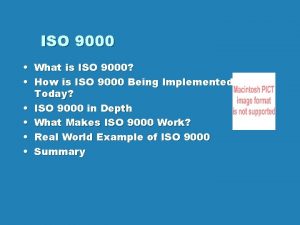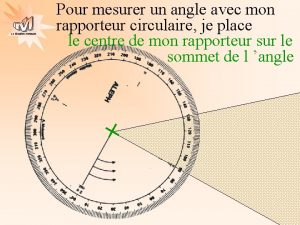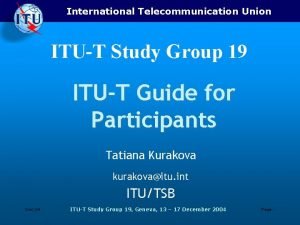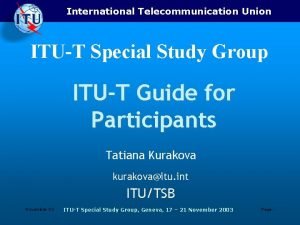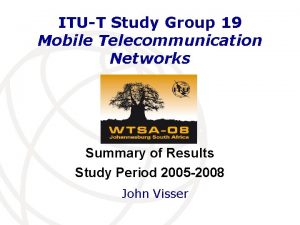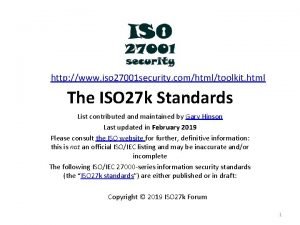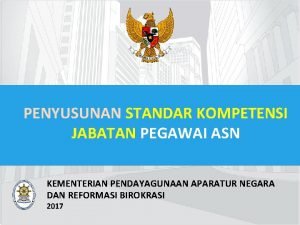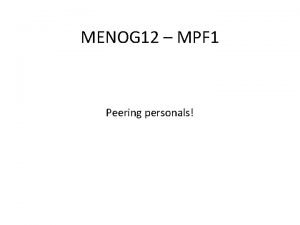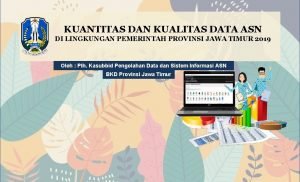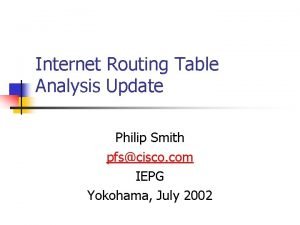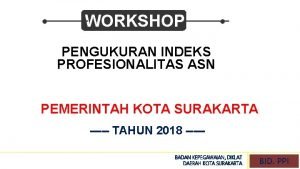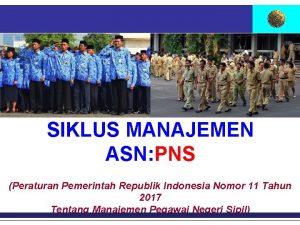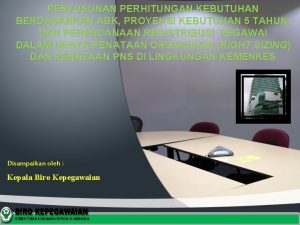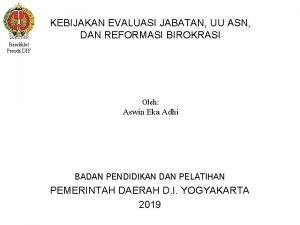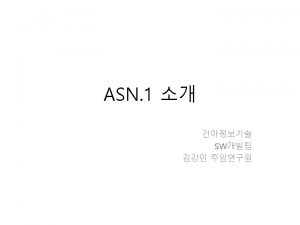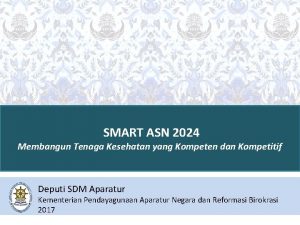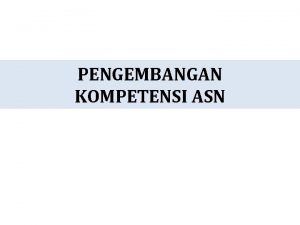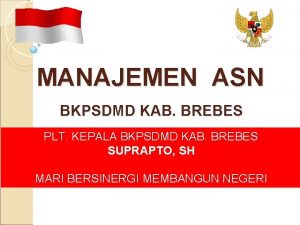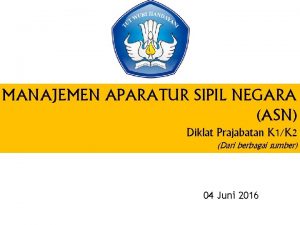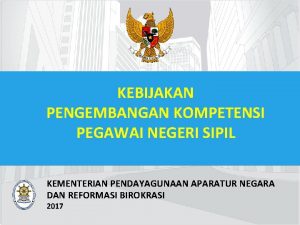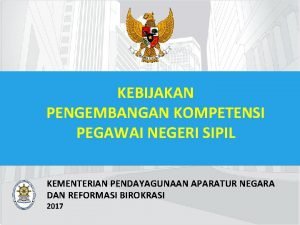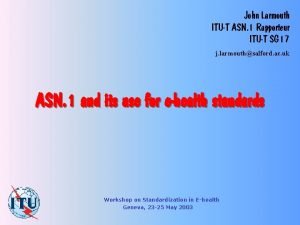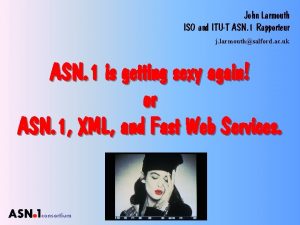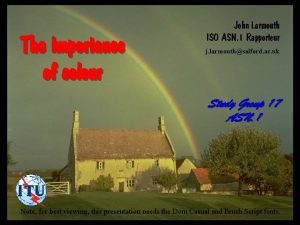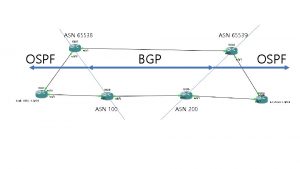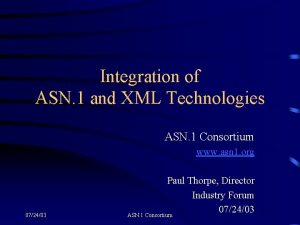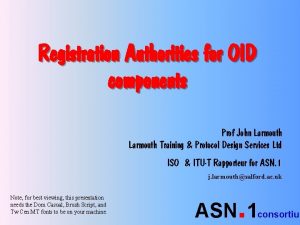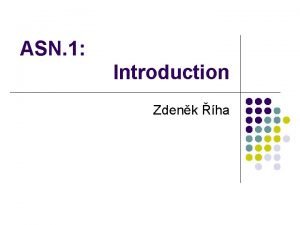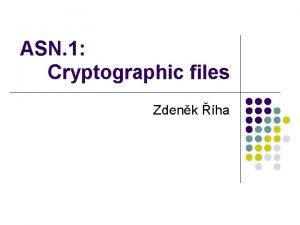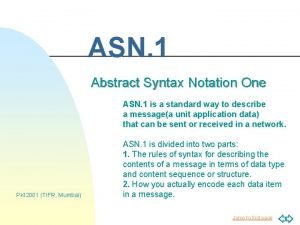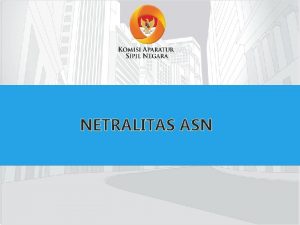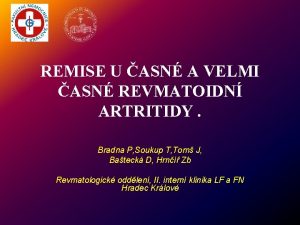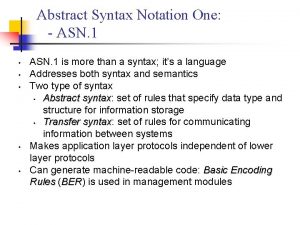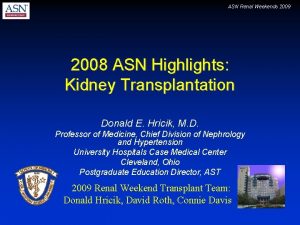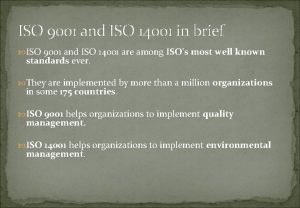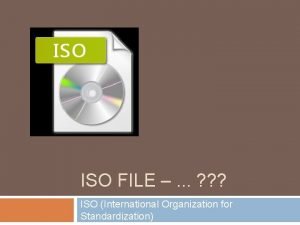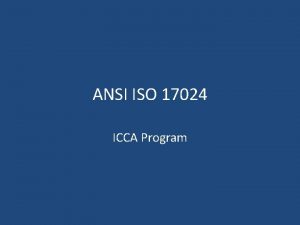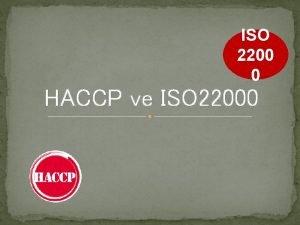John Larmouth ISO and ITUT ASN 1 Rapporteur


























![“Coloring” for different XML syntax BBCard : : = SEQUENCE { name [ATTRIBUTE] IA “Coloring” for different XML syntax BBCard : : = SEQUENCE { name [ATTRIBUTE] IA](https://slidetodoc.com/presentation_image_h2/4dd7b6e9b3e4f9e481989144b181850b/image-27.jpg)

![The C data-structure for the base-ball card typedef struct BBCard { char name [61] The C data-structure for the base-ball card typedef struct BBCard { char name [61]](https://slidetodoc.com/presentation_image_h2/4dd7b6e9b3e4f9e481989144b181850b/image-29.jpg)

















- Slides: 46

John Larmouth ISO and ITU-T ASN. 1 Rapporteur j. larmouth@salford. ac. uk ASN. 1 is getting sexy again! or ASN. 1, XML, and Fast Web Services.

Whoops - did I mean that? S N A . 1

So – How Sexy? n n XML is sexy! Multiple layers of XML support in ASN. 1 Web Services is even more sexy! Fast Web Services are coming soon!

ASN. 1 - lineage n n n ASN. 1 was borne around 1982 ish First ASN. 1 Standard (CCITT X. 409) in 1984 Borne from X. 400 (Mother with an early child, and the e-mail standard the world *should* have had!) Fathered by X. 500 (Certified insane at birth, but totally secure) Grand-parents (OSI) died prematurely and are not discussed in polite conversation today Married XML, and begat Fast Web Services

A shorter history of protocol specification

The Montagues and the Capulets (Contending Philosophies) (With apologies to William Shakespeare)

Understanding of protocol specification techniques n n n 1. 5 billion seconds ago …. . Computers started to communicate Major advances every 150 million seconds There was a need for – – n A means of syntax (data structure) specification Procedure (sequence) specification Test suite specification Validation And tools to support rapid implementation!

The Montagues and Capulets n n n A long and on-going civil dispute Montagues => Binary-based specification Capulets => Character-based specification With apologies to William Shakespeare and to those from a non-UK culture!

The stone-age Montagues Diagrams of bits and bytes - e. g. IPv 4 (The earliest approach, simple and clear, but focusing totally on the bits-on-the-line. ) Tool support not possible - but see ECN discussion. Extensibility support crude - based on reserved fields.

The stone-age Capulets n n n Simple “command lines” – in ASCII! Three character mnemonics and error codes (eg “ 200 OK”) Simple comma-separated parameters Good for simple dialogues Extensibility by adding commands in V 2, with unknown commands ignored by V 1 systems

The Bronze Age Montagues invent TLV and Tabular Notation n n Each PDU and each parameter has an ID (or Type), a Length, and a Value Tables list each parameter: Tabular Notation And Yuck – we are still going this route in 2003!

Tabular Notation and TLV was a breakthrough – should have been patented! n n Extensibility was EXCELLENT. Version 1 systems just skipped (using TLV) anything they did not know. Tool-support, however, not possible. But it was verbose! But not as verbose as the character-based encoding used by the Capulets!

The Bronze Age Capulets invent BNF n n The Capulets’ main concern was with precise specification of correct syntax This was the dawning of Backus Naur Form (BNF). This potentially allowed more complex information to be specified in a “command”. But it never really made it to the modern era of automatic mapping to Java, C++ etc.

150 Million seconds after the Bronze Age n Recognition of: – Separation of abstract and transfer syntax – (This is jargon for “content definition” and “encoding” or “syntax”) – Encoding rules n n n ASN. 1 specs define a de facto API (message content) Tools emerge to support the transformation of ASN. 1 to an API, and the encoding of data across that API Profits for all! ASN. 1 gets really Sexy!

ASN. 1 deployment n Wide use in a large range of industries: – – – n Keeping the lights burning Portable phones – we need them Birthday presents on time Traffic lights Aircraft fly safely Multimedia standards Many other industrial sectors – Most recently, biometrics

Without ASN. 1: – – – X The lights go out! Portable phones don’t work! Parcels get lost! Traffic lights fail! Aircraft fall from the sky! Your impending marriage suffers as Net. Meeting fails! X X X On second thoughts – it might be a better world?

The emergence of ECN n n n Ambitious Use ASN. 1 with a formal encoding notation to define any (binary) protocol ETSI-funded Took off slowly But very much still of interest Not the subject for today, but gives transition from ad hoc binary to XML encoding

300 Million seconds later, the Capulets develop XML n n n Focus still on what is correct syntax, not content (This is still bad. What is syntax variation and what is a difference in the message? Covert channels. ) Came out of SGML and HTML The “X” does not mean e. Xtensibility” Essentially a TLV style of encoding, but with human readable “<Start>…. </End>” wrappers Rapidly gained popularity! Idiots can understand it! Oh dear!

And finally, after another Million seconds n n ASN. 1 develops XML Encoding Rules “Coloring” added to allow control of (for example) attributes v elements Romeo and Juliet marry!

EXAMPLES (If you can’t understand the examples at first glance, something is wrong!)

A simple invoice Invoice : : = SEQUENCE { number INTEGER, name UTF 8 String, details SEQUENCE OF line-item Line. Item. Pair, charge REAL, authenticator BIT STRING} Line. Item. Pair : : = SEQUENCE { part-no INTEGER, quantity INTEGER }

Line. Item. Pair in XSD! <xsd: complex. Type name=“Line. Item. Pair"> <xsd: sequence> <xsd: element name="part-no" type="xsd: number"/> <xsd: element name="quantity" type="xsd: number"/> </xsd: sequence> </xsd: complex. Type> Compare: Line. Item. Pair : : = SEQUENCE { part-no INTEGER, quantity INTEGER } How sexy is that – half the size!

An example Invoice (1) <Invoice> <number>32950</number> <name>funny-name with < </name> <details> <line-item> <part-no>296</part-no> <quantity>2</quantity> </line-item> Cont

An example Invoice (2) Continuation <line-item> <part-no>4793</part-no> <quantity>74</quantity> </line-item> </details> <charge>397. 65</charge> <authenticator> EFF 8 E 976 5403 629 F </authenticator> </Invoice>

A base-ball card defined BBCard : : = SEQUENCE { name IA 5 String (SIZE (1. . 60)), team IA 5 String (SIZE (1. . 60)), age INTEGER (1. . 100), position IA 5 String (SIZE (1. . 60)), handedness ENUMERATED { left-handed (0), right-handed (1), ambidextrous (2) }, batting-average REAL }

A base-ball card value in XML syntax <BBCard> <name>Jorge Posada</name> <team>New York Yankees</team> <age>29</age> <position>C</position> <handedness><right-handed/></handedness> <batting-average>0. 277</batting-average> </BBCard>
![Coloring for different XML syntax BBCard SEQUENCE name ATTRIBUTE IA “Coloring” for different XML syntax BBCard : : = SEQUENCE { name [ATTRIBUTE] IA](https://slidetodoc.com/presentation_image_h2/4dd7b6e9b3e4f9e481989144b181850b/image-27.jpg)
“Coloring” for different XML syntax BBCard : : = SEQUENCE { name [ATTRIBUTE] IA 5 String (SIZE (1. . 60)), team [ATTRIBUTE] IA 5 String (SIZE (1. . 60)), age INTEGER (1. . 100), position IA 5 String (SIZE (1. . 60)), handedness [TEXT] ENUMERATED { left-handed (0), right-handed (1), ambidextrous (2) }, batting-average REAL }

The new XML syntax <BBCard name = “Jorge Posada” team = “New York Yankees” > <age>29</age> <position>C</position> <handedness>right-handed</handedness> <batting-average>0. 277</batting-average> </BBCard>
![The C datastructure for the baseball card typedef struct BBCard char name 61 The C data-structure for the base-ball card typedef struct BBCard { char name [61]](https://slidetodoc.com/presentation_image_h2/4dd7b6e9b3e4f9e481989144b181850b/image-29.jpg)
The C data-structure for the base-ball card typedef struct BBCard { char name [61] ; char team [61] ; short age ; char position [61] ; enum { left_handed = 0, right_handed = 1, ambidextrous = 2, } handedness ; float batting_average ; } BBCard ;

A personnel-record defined (1) Personnel. Record : : = SEQUENCE { name Name, title Visible. String, number Employee. Number, date. Of. Hire Date, name. Of. Spouse Name, children SEQUENCE OF child Child. Information DEFAULT {} }

A personnel-record defined (2) Child. Information : : = SEQUENCE { name Name, date. Of. Birth Date} Name : : = SEQUENCE { given. Name Visible. String, initial Visible. String, family. Name Visible. String} Employee. Number : : = INTEGER Date : : = Visible. String -- YYYYMMDD

An example personnel-record (1) <Personnel. Record> <name> <given. Name>John</given. Name> <initial>P</initial> <family. Name>Smith</family. Name> </name> <title>Director</title> <number>51</number> <date. Of. Hire>19710917</date. Of. Hire> <name. Of. Spouse> <given. Name>Mary</given. Name> <initial>T</initial> <family. Name>Smith</family. Name> </name. Of. Spouse Cont

An example personnel-record (2) <children> <child> <name> <given. Name>Ralph</given. Name> <initial>T</initial> <family. Name>Smith</family. Name> </name> <date. Of. Birth>19571111</date. Of. Birth> </child> <name> <given. Name>Susan</given. Name> <initial>B</initial> <family. Name>Jones</family. Name> </name> <date. Of. Birth>19590717</date. Of. Birth> </children> </Personnel. Record>

A count of octets for the personnel-record value n n n With white-space omitted, 653 octets Fully human-readable with white-space, can be double that! (Who cares? ) BER 136 octets PER 94 octets (An unfriendly example? ) ZIP compression …. . But does size matter anyway? (Or transaction processing speed? )

ASN. 1 support for XML – Basic and simple n n n n XML Encoding Rules A simple, fixed, encoding in XML for any type defined using ASN. 1 No use of attributes No use of Lists No use of xsi: type or xsi: nil No support for namespaces Simple and easy

Add XML Encoding Instructions n n n Do not confuse with ECN – a similar but different concept Allows use of XML ATTRIBUTES Allows use of LIST for SEQUENCE OF Either a prefixed encoding instruction (like a TAG), or an encoding control section in the module Provides anything a right-minded person might want!

Now add MODIFIED-ENCODINGS n n Causes the ASN. 1 XML encodings to be the same as XSD encodings for the same type For example, the BOOLEAN type encodes as – true or false n And not as – <true/> or <false/>

Now add more encoding instructions n n Full support for anything you can do with XSD Yuck! Mapping from XSD to ASN. 1 (X. 694) Reverse not provided – politics!

ASN. 1 is an XML Schema notation n Mo. U (ISO, IEC, ITU-T, UN/ECE and others) MG recommendation: E-business standards should use both XSD and ASN. 1 as XML Schema notations n n OASIS UBL uses both XSD and ASN. 1 OASIS XCBF uses only ASN. 1 as the Schema notation

Web Services n n Machine-to-machine using Web protocols (SOAP wrappers) Flexible publishing of services (parameters etc) with WSDL Mapping into Java etc code XML encoded transfers

And now the REALLY sexy stuff n n n *Fast* Web Services = ASN. 1 and PER! Being promoted by SUN Progressing as ITU-T X. 695 | ISO 8825 -6 Linked to binary encoding of XML data ASN. 1 SOAP, ASN. 1 encoding of the XML Infoset A new lease of life for ASN. 1? Watch this space!

Binary XML – marriages again! n n n Schema driven Schema-less Importance of the XML Infoset Simple compression Many options XSD -> ASN. 1 -> PER

PER extensions n n n Several aims – not yet mature Simplified ECN for common cases Better support for Binary XML: – – – n Support for message fragments Support for partial messages Variable and partial compression Namespace support Added element support A further marriage – XML text goes into PER binary encodings

Syntax for specification n n Relax NG compact syntax – ASN. 1 -like Compact syntax for XSD under discussion XML syntax for ASN. 1 under discussion UML class diagram syntax for ASN. 1 – a UML profile – beginning (how sexy is UML? ) So what are the differences? Why does the spec language matter? – – A variety of encoding rules Mappings to C, C++ Java Efficient processing of messages The language you love or hate!

In conclusion n n n ASN. 1 made major break-throughs in each of the last few decades The abstract syntax concept The Information Object concept (not discussed in this presentation) Embracing XML encodings ECN and then Encoding Instructions And now Fast Web Services How much more sexy (and useful!) can you get?

Whoops - not that again! S N A Finito! . 1
 Used il acl 9000
Used il acl 9000 Rapporteur circulaire aleph
Rapporteur circulaire aleph Rapporteur à quatre chandelles
Rapporteur à quatre chandelles Itu t study groups
Itu t study groups Ittut
Ittut Itut
Itut Cabs.itut
Cabs.itut Cabs itut
Cabs itut Plano iso e
Plano iso e Iso 8583 to iso 20022 mapping
Iso 8583 to iso 20022 mapping Iso 27102
Iso 27102 Ohsas 18001 iso 14001 comparison
Ohsas 18001 iso 14001 comparison Iso 9000 iso 22000
Iso 9000 iso 22000 Organisasi asn
Organisasi asn Organigramme asn
Organigramme asn Tahapan-tahapan standar kompetensi jabatan
Tahapan-tahapan standar kompetensi jabatan Asn 8075
Asn 8075 Ip asn bkd jatim
Ip asn bkd jatim Asn 7018
Asn 7018 Contoh metode insiden kritis
Contoh metode insiden kritis Single address space
Single address space Aplikasi indeks profesionalitas asn
Aplikasi indeks profesionalitas asn Bksdm surakarta
Bksdm surakarta Asn abstract submission
Asn abstract submission Ropeg kemenkes kenaikan pangkat fungsional
Ropeg kemenkes kenaikan pangkat fungsional Asn.1 syntax
Asn.1 syntax Manajemen talenta asn ppt
Manajemen talenta asn ppt Auditor manajemen asn
Auditor manajemen asn Asn scientific sessions
Asn scientific sessions Strima
Strima Ghsp crypto
Ghsp crypto Strategi kebijakan dan kompetensi manajemen pemerintahan
Strategi kebijakan dan kompetensi manajemen pemerintahan Siklus manajemen asn
Siklus manajemen asn Proyeksi kebutuhan pegawai 5 tahun ke depan
Proyeksi kebutuhan pegawai 5 tahun ke depan Contoh iktisar
Contoh iktisar Contoh bad practice
Contoh bad practice Asn safety solutions
Asn safety solutions Kelas jabatan fungsional tertentu
Kelas jabatan fungsional tertentu Asn.1 이란
Asn.1 이란 Smart asn 2024
Smart asn 2024 Format penilaian kinerja kepala sekolah
Format penilaian kinerja kepala sekolah Contoh kompetensi asn
Contoh kompetensi asn Contoh manajemen asn di sekolah
Contoh manajemen asn di sekolah Fungsi asn
Fungsi asn Manajemen asn
Manajemen asn Contoh kompetensi asn
Contoh kompetensi asn Contoh kompetensi asn
Contoh kompetensi asn
